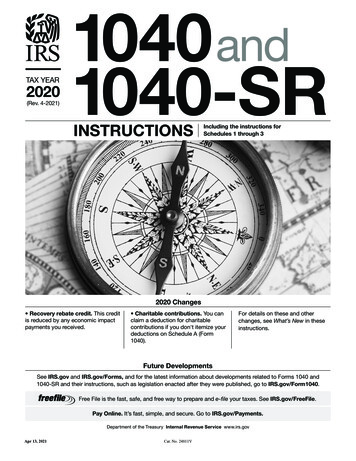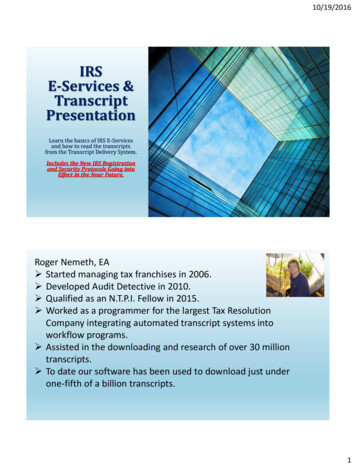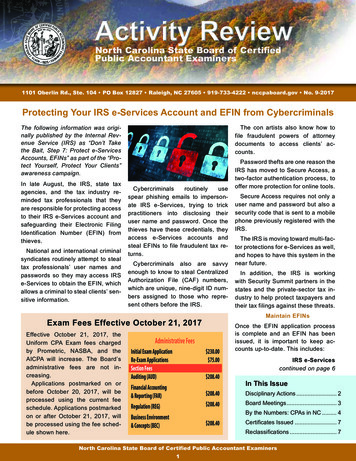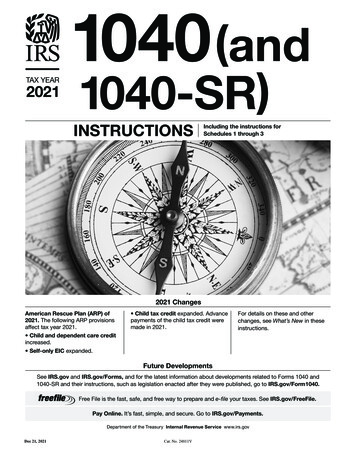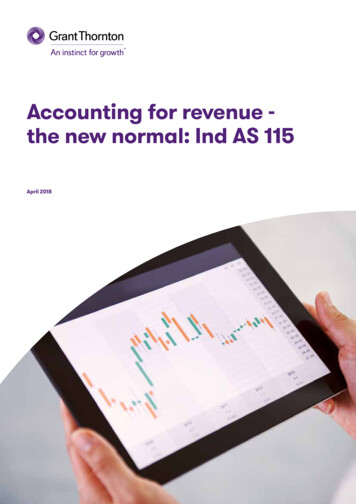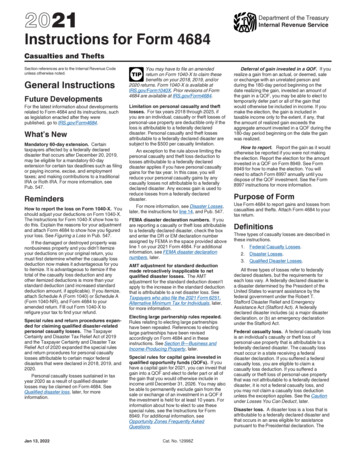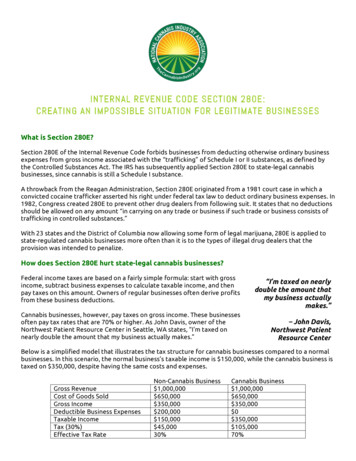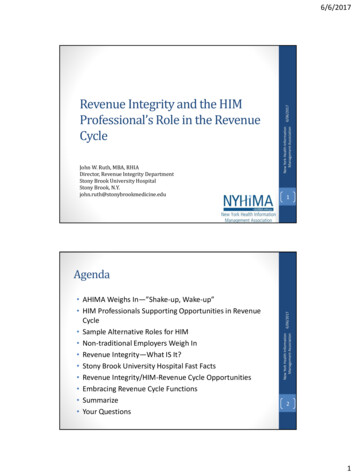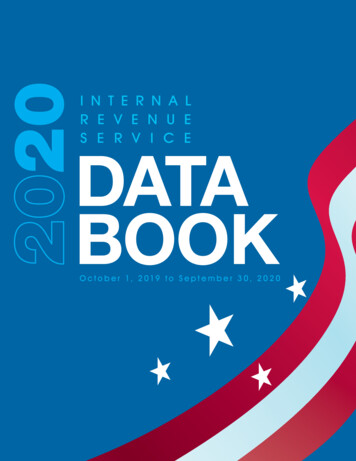
Transcription
2020I N T E R N A LR E V E N U ES E R V I C EDATABOOKO c t o b e r 1, 2 019 t o S e p t e m b e r 3 0 , 2 0 2 0
Internal Revenue Service Data Book, 2020Department of the TreasuryInternal Revenue ServiceCharles P. RettigCommissionerBarry W. Johnson (Acting)Chief Research and Analytics OfficerDavid P. Paris (Acting)Director, Statistics of Income DivisionMichael E. Weber (Acting)Chief, Individual and Tax-Exempt BranchWayne K. KeiChief, Data Dissemination SectionThe IRS MissionProvide America’s taxpayers top-quality service by helping themunderstand and meet their tax responsibilities and enforce thelaw with integrity and fairness to all.
This report describes activities conducted bythe Internal Revenue Service during Fiscal Year2020 (October 1, 2019, through September 30,2020). It provides information on returns filed andtaxes collected, enforcement, taxpayer assistance, the IRS budget and workforce, and otherselected activities.When using information from this report, citethe Internal Revenue Service Data Book, 2020,as follows—Internal Revenue ServiceData Book, 2020Publication 55–BWashington, DCJune 2021ContentsAcknowledgments . vLetter from the Commissioner . viIRS Response to the COVID-19 Pandemic .viiiTaxpayer Attitudes and Service Channel Preferences . xList of Statistical Tables . xiiReturns Filed, Taxes Collected, and Refunds Issued . 1Service to Taxpayers . 21Compliance Presence . 33Collection Activities, Penalties, and Appeals . 57Chief Counsel . 63IRS Budget and Workforce. 69Data Sources, by Subject Area and Table Number . 75Principal Officers of the Internal Revenue Service . 76Principal Officers of the Internal Revenue ServiceOffice of Chief Counsel .78Commissioners of Internal Revenue .79Chief Counsels for the Internal Revenue Service . 80Internal Revenue Service Organization . inside back cover
Internal Revenue Service Data Book, 2020AcknowledgmentsInternal Revenue Service OfficesAppealsCriminal InvestigationTax Exempt and Government EntitiesPaula BayleyStephen D. HarrisHans J. VenableFrank KowalkowskiDavy M. LeightonTaxpayer AdvocateChief CounselCristina L. JacobsHilary A. FerrellChief Financial OfficerAdrian T. Dance, Jr.Matthew R. GrayEquity, Diversity and InclusionCharles R. MartinsenOnline ServicesJoshua JessarResearch, Applied Analytics,and StatisticsKirstee Sarah E. HildebrandDonna BaldwinDonald J. JemisonJeff MatsuoLouis C. MalfaitJoAnn F. MorasseVicki M. StevensWage and InvestmentHelen BassStaci StantzShadlyn WolfeSmall Business / Self-EmployedCharles A. MessingShameka AndersonJeshal PatelBrandy BrewsterAfzaal H. ShamsieNyna CoxJoseph SkopicTerri GrantSharon TelesfordJames HellerCommunications & LiaisonKimberly A. KnowltonDarryl E. LiuBarlo BrownBob D. SchwallerMichael DeneroffWilliam Zanieski, Jr.Statistics of Income DivisionManaging EditorsKelly D. DaubermanGlenn J. HentzJessica N. HollandLayout DesignerClay R. MoultonPublishing Services CoordinatorClay R. MoultonTechnical EditorsJames R. HobbsBarry W. JohnsonThe Internal Revenue Service Data Book OnlineThe Internal Revenue Ser vice Data Book tables for the current year and previous years may be found online -data-book. An archive of historical Data Books and its predecessor from 1863 to 2020is also available on the site. For additional information, contact Statistical Information Services at 202–803–9285 or e-mail sis@irs.gov.v
Internal Revenue Service Data Book, 2020Letter from the CommissionerI’m pleased to present the Fiscal Year2020 Internal Revenue Service DataBook. This publication will give everyone an idea of the important work thattakes place at the IRS, year in and yearout, to help taxpayers. We also hopeit will help illustrate IRS accomplishments over the past year and the manyways our employees provide serviceto the nation.of Economic Impact Payments (EIPs)to help millions of Americans facingfinancial hardship. IRS employeesworked many long hours to developnew tools and meaningful guidance tosimultaneously deliver the first roundof nearly 162 million payments totalingmore than 271 billion in record timewhile still keeping the annual filingseason on track. In fact, millions ofAmericans started seeing EIPs showBy sharing this information, we want ev- up in their bank accounts within 14eryone to understand the scope of our days after the CARES Act was enacted.work. My experience as Commissionerhas strengthened my belief that a Realizing how difficult the pandemicfully functioning IRS is critical to the has been for so many Americans, wesuccess of our nation. Each year, the also moved quickly to provide imporIRS collects more than 3 trillion in tant administrative relief. We postponedtaxes and generates approximately 96 the deadline for individuals to file andpercent of the funding that supports pay Federal income tax from April 15,the Federal Government’s operations. 2020, to July 15, 2020—the latest taxWe serve and interact with more deadline ever. Furthermore, we impleAmericans than any other public or mented the IRS People First Initiative,private organization.under which we temporarily adjustedour processes to help people and busiIn 2020, the IRS found itself in unchart- nesses during these uncertain times.ed waters, as did the entire nation. TheCOVID-19 pandemic presented some To protect the health and safety of taxof the greatest challenges to the IRS in payers and the IRS workforce, we temits history, both in terms of being able porarily scaled back operations, takingto carry out our mission and in protect- such steps as closing most of our ofing the health and safety of taxpayers fices and Taxpayer Assistance Centers,and our own workforce.discontinuing face-to-face operations,and suspending our telephone helpThe IRS’s efforts to help the nation lines. As a result, our website, IRS.gov,weather the financial effects of the served as a critical hub of tax informapandemic began in March when tion. It should be no surprise that visitsCongress approved the Coronavirus to our website in Fiscal Year (FY) 2020Aid, Relief and Economic Security skyrocketed, rising 146 percent, from(CARES) Act and other important tax- almost 651 million visits in FY 2019 torelief legislation. This included delivery more than 1.6 billion in FY 2020. Useviof the “Where’s My Refund?” tool increased by 37 percent, with more than505.6 million inquiries in FY 2020. Dueto reductions in capabilities to providein-person and phone assistance whileoffices were closed, live toll-free callvolume decreased 16 percent and contacts at Taxpayer Assistance Centersdecreased by 54 percent.Even with those challenges, the IRS remained committed to its core mission.We didn’t have a playbook for how torespond to a pandemic that shut downor slowed wide segments of the U.S.economy. Nonetheless, thanks to theagility and flexibility of our workforce,the IRS moved forward, rapidly switching to a virtual work environment andshifting the majority of our employeesto working remotely to protect theirsafety for as long as necessary. Infact, with the critical support of ourInformation Technology division, weset a record with more than 61,000employees teleworking at one time.Our IT division also provided the equipment necessary to allow thousands ofour customer service representativesto telework, which gave critical help tothe IRS in its efforts to resume phoneassistance.I’m very proud that our employeessuccessfully extended and deliveredthe longest filing season on record forthe nation. As events unfolded in thespring and summer of 2020, we continued to process electronic tax returns,issue direct deposit refunds, and accept electronic payments. Throughout
Internal Revenue Service Data Book, 2020this Data Book, you’ll find evidenceof our success. In FY 2020, the IRSprocessed more than 240 million taxreturns and forms and collected nearly 3.5 trillion in Federal taxes. The IRSissued more than 736 billion in refunds (including 268.3 billion in EIPsissued during the fiscal year, whichwere classified as refunds).As in years past, in the 2020 DataBook, you’ll find insights on taxpayers’ opinions from the long-runningComprehensive Taxpayer AttitudeSurvey that has helped inform IRSservice improvements since 1999.As we implement provisions of theTaxpayer First Act, we continue to enAs public servants, my message to IRS gage in thoughtful conversations withemployees has consistently been that taxpayers and employees to improveWe want taxpayers to know we’re all the people we serve are important, IRS operations and our interactionscontinuously working to modernize none more or less so than any other, with customers.our systems to improve taxpayers’ and the value of taxpayer servicesexperience when they interact with us. must be measured through the eyes of You’ll find many interesting statisticsOur IT systems are built to handle the the taxpayer. We strive to put taxpay- within the Data Book, but there’ssurge that comes every tax season. I ers first and enhance their experience more to the IRS story. What can’t beam pleased to report that when the through improved tools, education, tabulated is how much IRS employees2020 filing season opened on January guidance, and outreach. We remain care. Our agency is made up of people27, on that first day, we set records by focused on assisting historically un- who give back to their communitiesprocessing more than 2.275 million e- derserved communities, including and help one another. Our employeesfiled returns in an hour and at a rate of underrepresented, lower-income, and provide significant support for those631 submissions per second, without limited English proficiency taxpayers. devastated by hurricanes, wildfires, anderror. The previous records were setother natural disasters, and across theset the prior year, on January 28, 2019, We are determined to provide relevant nation, they did amazing work in theirat the rates of 1.9 million submissions clear guidance, forms, and instructions communities to help those impacted byin an hour at 536 per second.in plain language—and in multiple lan- COVID-19. You can read more aboutguages—to assist and appropriately this in the IRS 2020 Progress Update,In addition to improving service to all respect the needs of diverse com- an annual report on IRS.gov coveringtaxpayers, the IRS is also commit- munities throughout our country. We the same period as the Data Book.ted to having a strong, visible, robust took a number of aggressive steps totax enforcement presence. We have expand information and assistance As this publication illustrates, the IRSshifted significant audit resources available to taxpayers in additional remains dedicated to providing highand technology to increase our focus languages, such as: providing the 2020 quality service to taxpayers and mainon high-income taxpayers, including Form 1040 in Spanish for the first time; taining the integrity of the tax system,those who have failed to file returns making Publication 1, Your Rights as while also protecting the health of itsand those engaged in certain types a Taxpayer, available in 20 languages; workers and American taxpayers. Theof abusive transactions. This is about and giving taxpayers who call us ac- ways the IRS workforce has respondfairness. We are committed to pur- cess to over-the-phone interpreter ser- ed to the challenges we faced thissuing those who would intentionally vices in more than 350 languages. I’m year serve to highlight the significantevade their tax obligations to assure incredibly proud of the IRS for moving role the IRS plays in the overall healthlaw-abiding citizens that everyone is forward on these and other initiatives. of our country—in 2020 and beyond.paying what the law requires. Despitethe challenges presented by the pandemic, in FY 2020, the IRS closedalmost 510,000 examinations. Andthe IRS administers the tax code asefficiently as possible; the cost of collecting 100 was 35 cents in FY 2020.Chuck RettigCommissioner of Internal Revenuevii
Internal Revenue Service Data Book, 2020Number of Economic Impact Payments by Type,Calendar Year 2020050M122.5MElectronically100M150M35.8MPaper check200M3.6MDebit cardAmount of Economic ImpactPayments, Calendar Year 2020First roundof EIPSecond roundof EIP 141.5B 271.4BFirst roundof EIPTotal: 412.9B112.8MElectronically25.7MPaper check8.0MDebit cardSecond roundof EIPSOURCE: IRS, Statistics of Income, Coronavirus Aid, Relief, and Economic Security Act (CARES Act) StatisticsIRS Response to the COVID-19 PandemicThe COVID-19 pandemic impactednearly every facet of life during 2020. Inresponse to the pandemic, IRS modified the way it conducted day-to-dayactivities, provided tax administrationrelief to millions of taxpayers, andserved an essential role by implementing legislative programs that providedfinancial assistance. The impact ofthese activities is evident in almostevery table included in the Fiscal Year2020 Data Book. Highlights of theseactivities are described below.Protecting Employees andProviding Administrative Reliefto TaxpayersThe IRS’s top priority throughoutthe COVID-19 pandemic has beento protect the health and safety oftaxpayers and the IRS workforce.This required extraordinary actionssuch as closing taxpayer assistancecenters, submission processing centers, and offices nationwide followingFederal, State and local executiveStay At Home orders. Nonetheless,core IRS functions continued, and theIRS delivered the filing season withe-filing still in place.viiiThe IRS also accelerated the introduction of new technology that allowedthousands of employees to work fromhome. Still, some taxpayer interactions, especially those that rely onin-person or paper transactions, weredelayed relative to previous years.The IRS also eased the burden onpeople facing tax issues during theCOVID-19 pandemic by extending thedeadline for individuals to file and payFederal income tax from April 15, 2020,to July 15, 2020, and by launching thePeople First Initiative on March 25,2020. This initiative reduced the burdenon people with tax uncertainties byeasing payment guidelines, postponingcompliance actions, and suspendingmost collection enforcement activities,such as new notices of lien or levy fromApril 15, 2020, to July 15, 2020.The IRS also discontinued field visitsand in-person meetings to protect thesafety and health of its employees andtaxpayers. These decisions resulted indecreases in some examination activities relative to prior fiscal years, althoughin most cases these activities reboundedby the end of the calendar year.Facilitating Financial Assistanceto Millions of TaxpayersThe pandemic presented our nation with challenges to which theIRS responded by quickly facilitatingfinancial assistance to millions ofAmericans.The Coronavirus Aid, Relief, andEconomic Security (CARES) Act, enacted in March 2020, created a refundabletax credit for individuals. The advancepayment of this “2020 recovery rebatefor individuals” is referred to as the firstround of Economic Impact Payments(EIPs). The IRS issued 161.9 millionEIPs in the first round: 122.5 million bydirect deposit, 35.8 million by check,and nearly 3.6 million by debit card.The COVID-Related Tax Relief (CRTR)Act of 2020 was enacted in December,creating a second round of EIPs. TheIRS issued 146.5 million second-roundEIPs, including 112.8 million by directdeposit, 25.7 million by check, and 8million by debit card. Combined, theIRS provided 412.9 billion in relief under these programs. For information onEIPs issued by State during Fiscal Year2020, see Tables 7 and 8.
Internal Revenue Service Data Book, 2020Selected IRS.gov Coronavirus Web Page Views, Calendar Year 2020IRS.gov Web pagesNumber of page viewsGet My 23,756Get My Payment Frequently Asked equently-asked-questions134,315,039Economic Impact yments317,079,818Economic Impact Payment Information virus Tax mic-impact-paymentsNew Employer Tax editsNon-Filer nt-info-here704,287170,341,983SOURCE: Online Services.The IRS also administered legislativeprovisions providing economic reliefto businesses included in the FamiliesFirst Coronavirus Response (FFCR)Act, which was extended by the CRTR,and the Tax Certainty and DisasterTax Relief Act of 2020. Major provisions included: the Credit for Sick andFamily Leave; the Employee RetentionCredit, which was designed to encourage businesses to keep employees ontheir payroll; and a carryback for netoperating losses, which allowed businesses to carry back net operatinglosses over 5 years.Serving Taxpayers With NewOnline Tools and Web PagesTo help taxpayers claim COVID-19related relief payments and tax credits,and stay informed about issues relatedto the pandemic, IRS released onlinetools and published new coronaviruspages on IRS.gov: Get My Payment (GMP) enabledusers to check the status of theirEIPs or enter their bank accountinformation to receive their payment electronically. Ec o n o m i c I m p a ct Pay m e ntInfo r m atio n C e nte r p rovi d ed detailed information andanswers to frequently askedquestions. Coronavirus Ta x Relief Webpage consolidated news releases, statements, FAQs, guidance,partner materials, tax help, socialmedia, and other resources. New Employer Tax Credits Webpage provided a breakdown ofwhich employers qualify for thenew credits.I R S a l s o c o o r d i n a te d w i t h Ta xSof tware industr y par tners, whobuilt the Non-Filer: Enter PaymentInfo Here tool. This tool, which washosted outside of IRS.gov and linkedfrom the IRS.gov Website, allowedpeople who normally do not havea filing obligation to enter basic information so that they could receivetheir payment. The Non-Filer toolwas available for the first set of EIPpayments.Protecting Employees WhileEnsuring Continued OperationsThe IRS quickly implemented newprocedures to accommodate a rapidly expanding remote workforce asthe IRS shifted operations online.About 20,000 laptops were suppliedto employees, enabling them to workfrom home, ensuring continuity ofcritical services. To support the newlyexpanded teleworking employees,the IRS doubled its network capacityand increased network bandwidth tosupport maximum telework. By earlyJune, the IRS hit a new peak of morethan 56,000 remote employees working online simultaneously, which morethan doubled the previous peak ofabout 25,000.To ensure the continuation of plannedhiring and to protect new employeesfrom any unnecessar y in-personcontacts, the IRS modified the onboarding process and conducted itsfirst-ever virtual orientation on March30, 2020, for more than 170 new hires,with additional new hires in the weeksand months that followed.ix
Internal Revenue Service Data Book, 2020Taxpayer Attitudes and Service ChannelPreferencesMore than 2,000 taxpayers participated in the 2020 Comprehensive Taxpayer Attitude Survey (CTAS), providing important information about their points of view and service channel preferences. These taxpayer opinions, capturedby CTAS through cell phone, landline phone, and online interviews, have informed IRS decision-making since 1999.Highlights of the DataIt Is Every American’s Civic Duty To Pay Taxes Most taxpayers continued to view paying their fair share of taxes as their civic duty. This perspective has remainedstable since 2017, with a one-point decline in 2020.All Responses, 2017–20202020 All ResponsesCompletelyagree68%100%95%Mostly agree26%Mostlydisagree3%Completely/Mostly agree90%Completelydisagree2%85%80%No opinion1%0201720182019NOTE: Blended phone and online responses are not available prior to 2017.2020NOTES: Responses include both phone and online surveyresponses.No opinion includes: Don’t know/Not applicable/No response.What Is an Acceptable Amount To Cheat on Income Taxes? A majority of taxpayers still agreed that cheating on their income taxes is not at all acceptable. The percentageagreeing remained stable this year, following a rebound in 2019.All Responses, 2017–20202020 All Responses100%Not at all87%A little hereand there8%95%90%As muchas possible3%Not at all acceptable85%No opinion1%80%0201720182019NOTE: Blended phone and online responses are not available prior to 2017.x2020NOTES: Responses include both phone and online survey responses.No opinion includes: Don’t know/Not applicable/No response.Pie chart does not total 100% due to rounding
Internal Revenue Service Data Book, 2020Satisfaction With Personal Interactions With the IRS The percentage of taxpayers satisfied with their personal interactions with the IRS has held steady since 2017, withina two-point range, with most taxpayers being satisfied.All Responses, 2017–20202020 All Responses100%Somewhat49%95%Not very10%90%85%80%Very/Somewhat satisfiedNot at all6%75%No opinion5%70%65%Very30%0201720182019NOTE: Blended phone and online responses are not available prior to 2017.2020NOTES: Responses include both phone and online survey responses.No opinion includes: Don’t know/Not applicable/No response.Trust in the IRS To Protect Tax Records From Cyber Criminals The percentage of taxpayers agreeing that they trust the IRS to protect tax records from cyber criminals significantlyincreased in 2020.All Responses, 2017–20202020 All Responses100%Mostly stly agreeCompletelydisagree9%75%No opinion1%70%65%0201720182019NOTE: Blended phone and online responses are not available prior to 2017.Completelyagree31%2020NOTES: Responses include both phone and online survey responses.No opinion includes: Don’t know/Not applicable/No response.For more details from the 2020 Comprehensive Taxpayer Attitude Survey, go to https://www.irs.gov/pub/irs-pdf/p5296.pdf.xi
Internal Revenue Service Data Book, 2020List of Statistical TablesR e t u r n s F i l e d , Ta x e s C o l l e c t e d , a n d R e f u n d s I s s u e dPageTable 1. Collections and Refunds, by Type of Tax, Fiscal Years 2019 and 2020.3Table 2. Number of Returns and Other Forms Filed, by Type, Fiscal Years 2019 and 2020.4Table 3. Number of Returns and Other Forms Filed, by Type and State, Fiscal Year 2020.5Table 4. Number of Returns and Other Forms Filed Electronically, by Type and State, Fiscal Year 2020.8Table 5. Gross Collections, by Type of Tax and State, Fiscal Year 2020. 11Table 6. Gross Collections, by Type of Tax, Fiscal Years 1960–2020. 14Table 7. Number of Refunds Issued, by Type of Refund and State, Fiscal Year 2020. 16Table 8. Amount of Refunds Issued, Including Interest, by Type of Refund and State, Fiscal Year 2020. 18S e r v i c e t o Ta x p a y e r sTable 9. Selected Taxpayer Assistance and Education Programs, by Type of Assistanceor Program, Fiscal Year 2020.24Table 10. Selected Online Taxpayer Assistance, by Type of Assistance, Fiscal Year 2020.25Table 11. Taxpayer Advocate Service: Post-filing Taxpayer Assistance Program, by Type of Primary Issueand Relief, Fiscal Year 2020.27Table 12. Closures of Applications for Tax-Exempt Status, by Organization Type and Internal RevenueCode Section, Fiscal Year 2020.28Table 13. Receipts of Forms 8976, Notices of Intent To Operate Under Section 501(c)(4), Fiscal Year 2020.29Table 14. Tax-Exempt Organizations, Nonexempt Charitable Trusts, and Nonexempt Split-Interest Trusts,Fiscal Year 2020.30Table 15. Determination Letters Issued on Employee Retirement Plans, by Type and Disposition of Plan,Fiscal Year 2020. 31Table 16. Technical Activities and Voluntary Compliance Closures, Fiscal Year 2020.32Compliance PresenceTable 17. Examination Coverage and Recommended Additional Tax After Examination, by Typeand Size of Return, Tax Years 2010–2018.36Table 18. Examination Coverage: Recommended Additional Tax, and Returns with Unagreed Additional Tax,After Examination, by Type and Size of Return, Fiscal Year 2020.46Table 19. Examination Coverage: Returns Examined Involving Protection of Revenue Base, by Typeand Size of Return, Fiscal Year 2020.49xii
Internal Revenue Service Data Book, 2020Compliance Presence— continuedPageTable 20 Examination Coverage: Returns Examined Resulting in Refunds, by Type and Size of Return,Fiscal Year 2020. 51Table 21. Examinations of Tax-Exempt Organizations, Employee Retirement Plans, Government Entities,and Tax-Exempt Bonds, by Type of Return, Fiscal Year 2020. 53Table 22. Information Reporting Program, Fiscal Year 2020.54Table 23. Math Errors on Individual Income Tax Returns, by Type of Error, Fiscal Year 2020.55Table 24. Criminal Investigation Program, by Status or Disposition, Fiscal Year 2020.56Collection Activities, Penalties, and AppealsTable 25. Delinquent Collection Activities, Fiscal Years 2019 and 2020.59Table 26. Civil Penalties Assessed and Abated, by Type of Tax and Type of Penalty, Fiscal Year 2020.60Table 27. Appeals Workload, by Type of Case, Fiscal Year 2020.62Chief CounselTable 28. Chief Counsel Workload: All Cases, by Office and Type of Case, Fiscal Year 2020.64Table 29. Chief Counsel Workload: Tax Litigation Cases, by Type of Case, Fiscal Year 2020.67IRS Budget and WorkforceTable 30. Costs Incurred by Budget Activity, Fiscal Years 2019 and 2020. 71Table 31. Collections, Costs, Personnel, and U.S. Population, Fiscal Years 1990 – 2020.72Table 32. Personnel Summary, by Employment Status, Budget Activity, and Selected Personnel Type,Fiscal Years 2019 and 2020.73Table 33. Internal Revenue Service and Chief Counsel Labor Force, Compared to National Totals for Federaland Civilian Labor Forces, by Gender, Race / Ethnicity, Disability, and Veteran Status, Fiscal Year 2020.74xiii
Internal Revenue Service Data Book, 2020Gross Collections by Type of Tax, Fiscal Years 2011–2020Gross Collections by Type of Tax,Fiscal Year 2020 4.0T 3.5TTotal 4.0T 3.0TIndividualand estateand trustincometaxes 2.5T 2.0T 1.5TOther [1]Estateand gift taxes 3.5TExcise taxes 3.0T 1.0TBusinessincometaxes ncome taxes 2.5T2020[1] Includes employment, estate and gift, and excise taxes.SOURCE: Selected IRS Data Books, Table 1 2.0TReturns Filed, Taxes Collected,and Refunds IssuedThis section of the Data Book provides a broad overview of the main functionsperformed by the IRS: processing Federal tax returns and collecting revenue.It also provides additional details on returns filed, returns filed electronically,gross collections, and tax refunds by State and type of tax. 1.5TIndividualand estateand trustincometaxes 1.0T 0.5T0Highlights of the DataEmploymenttaxes2020SOURCE: 2020 IRS Data Book Table 1 The IRS collected close to 3.5 trillion in gross taxes in Fiscal Year (FY)2020 (Tables 1 and 5) and issuedalmost 303.3 mi
Internal Revenue Service Data Book, 2020 Internal Revenue Service Data Book, 2020 . such steps as closing most of our of- the IRS in its efforts to resume phone ing the health and safety of taxpayers fices and Taxpayer Assistance Centers, assistance. and


